Bulletin – June 1999 Consumer Credit and Household Finances
- Download 62KB
Introduction
In the 1990s, borrowing by households has grown quickly. In the early part of the decade, the growth was driven by housing lending (Graph 1). More recently, growth in other personal borrowings has picked up sharply.
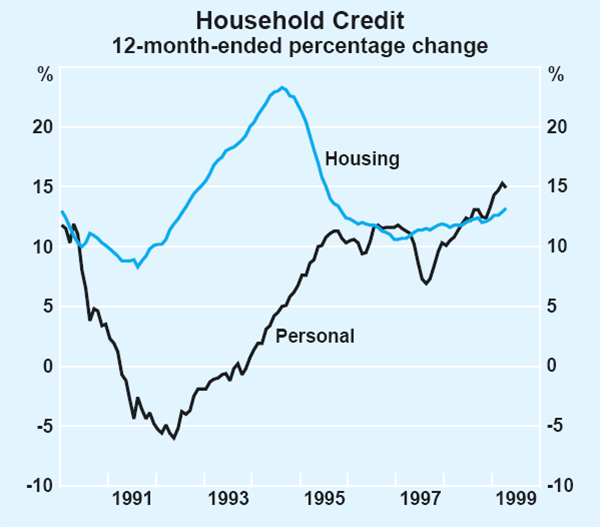
An important factor contributing to the quickening growth in personal credit has been innovations in products offered by banks, particularly the widespread introduction of loan products enabling households to draw on equity in their owner-occupied property. This type of loan gives explicit recognition, in the form of reduced interest rates, to the security offered by households as collateral for borrowing. A further influence on the growth of personal credit has been the increasing household preference toward the use of credit cards to make payments, partly in response to changes in banking services, and partly to take advantage of reward programs. More generally, continuing economic expansion, with low inflation and low interest rates, has boosted confidence among households, increasing their willingness to take on new debt.[1]
Recent Trends in Household Credit
The pattern of lending in the 1990s contrasts with that in the previous decade, when business credit grew much more strongly than lending to households (Graph 2). In the 1990s, these relativities have been reversed.
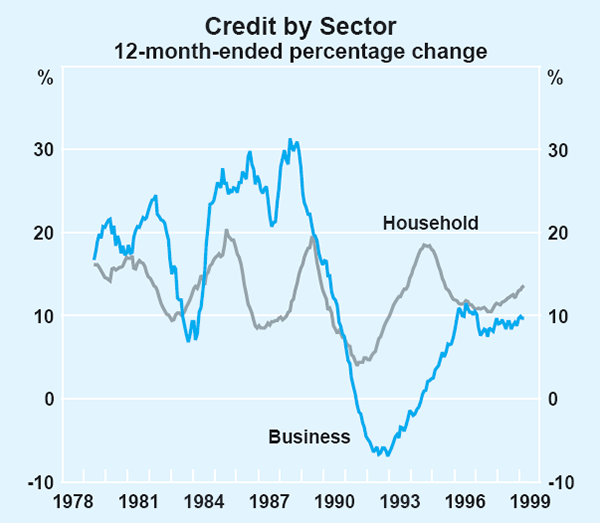
The acceleration in personal lending has been accompanied by a distinct shift in the way in which households borrow from banks. Until recently, the mainstay of personal lending was fixed-term (or ‘instalment’) loans. In the past two years, however, the level of fixed-term loans outstanding has been flat (Graph 3). Recent growth has been concentrated in revolving lines of credit; borrowing through these facilities has grown at an annual rate of around 30 per cent. Credit advanced through revolving lines of credit now represents about half of the personal loans outstanding to the household sector.
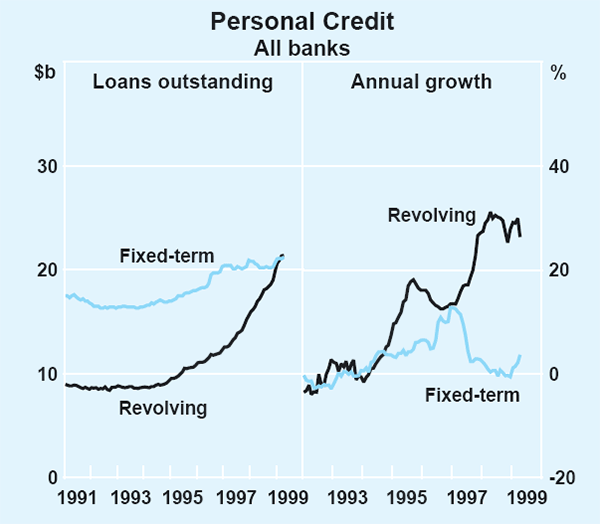
Revolving facilities offer borrowers more flexibility than instalment loans, as they have no maturity and no fixed repayment schedule. Some well-known examples of revolving lines of credit include: personal overdrafts (often secured by residential property, and sometimes referred to as ‘home equity loans’); margin loans (which are secured by shares); and credit cards. In recent years, lending on all of these products has grown strongly.
Personal Overdrafts
One factor boosting lending through personal overdrafts has been a marked reduction in interest rates on these products, especially when residentially secured. Over the past three years, the interest rate on residentially secured lines of credit has fallen by almost 5 percentage points (to 6.6 per cent), compared with the 2.75 percentage point reduction in the cash rate resulting from the easings of monetary policy.
Residentially secured lines of credit often have a chequebook or credit card as a feature of the product. They can, therefore, be used conveniently to fund the purchase of consumer durables, such as cars or whitegoods – the traditional uses for personal loans – or investments, such as shares or dwellings, or even for routine household expenditure.
A consequence of the flexibility of these products is that it is now more difficult to identify the purpose of household borrowing. Although borrowers are usually asked to specify the purpose of these loans when applying for a revolving line of credit, the approval process itself only establishes a credit limit. The timing and purpose of advances are subsequently at the discretion of the borrower, as is the ability to repay and redraw. Accordingly, it is not possible for banks to keep track of the purpose of these loans. It is possible, therefore, that a significant proportion of home equity loans is for housing investment. To that extent, current statistical collections may overstate growth in lending for consumer purposes while understating that for housing.
Margin Lending
While some lenders have promoted the use of residentially secured lines of credit as a means for households to invest in the share market, the extent to which households have used such products for this purpose is difficult to gauge.
Banks and some stockbrokers have also promoted margin lending facilities to enable individuals to finance the acquisition of shares. Margin loans are secured by the shares to be purchased. Lending institutions will generally lend up to a maximum of 70 per cent of the market value of the shares to be purchased; investors provide the balance in equity, either as cash or an existing portfolio of approved shares.
The Reserve Bank has conducted a survey of the major institutions offering margin lending facilities. At the end of 1998, there was at least $4.2 billion of margin loans on the books of banks and large stockbrokers; this was double the amount calculated from a similar survey in 1996. This increase in margin lending accounts for about one-fifth of the rise in personal debt over the period, excluding borrowings on credit cards.
While margin lending extends access to the share market, increased gearing via margin loans increases investors' exposure, magnifying both the potential gains and losses from market fluctuations. With the potential for large swings in share prices, margin lending is a relatively risky form of financing. Reflecting the greater degree of risk, interest rates on margin loans are currently 1 to 2 percentage points higher than those on residentially secured loans.
Credit Cards
Debt outstanding on bank-issued credit cards has also grown strongly (Graph 4). Two sorts of cards are available: one with an interest-free period (and an annual fee); the other accrues interest immediately (but has no annual fee). If a customer with a card with an interest-free period repaid all of their credit card borrowings in full each month, they would pay no interest. In other words, the only direct cost to such cardholders would be the annual fee. Growth in credit card debt has been concentrated in credit cards with an interest-free period, suggesting that users are not seeking longer-term finance to make purchases, but rather are using credit cards as a medium simply to make payments.
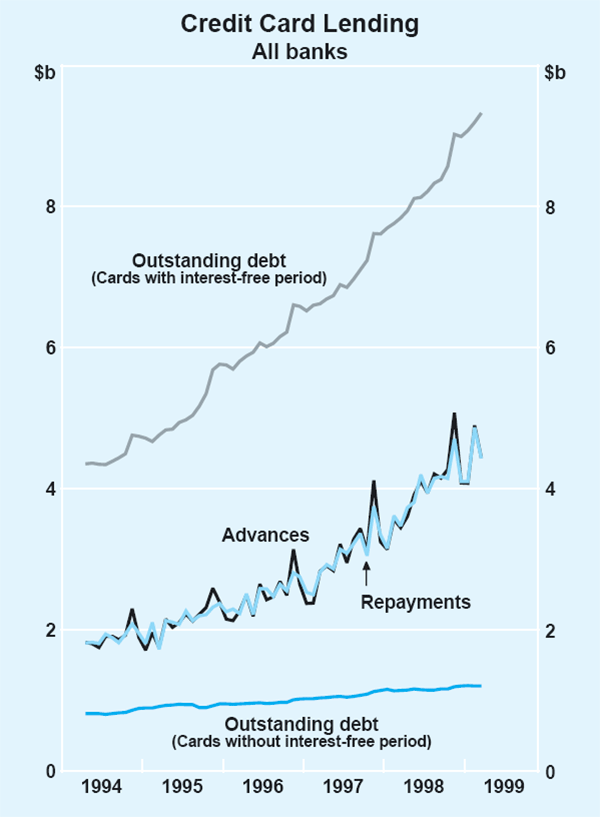
The greater use of credit cards to make payments reflects several factors: incentives available under loyalty and other reward programs; a desire by households to minimise the impact of fees charged by banks on transaction accounts; and the increased convenience of using credit cards to make payments by telephone or computer.
A number of other patterns in credit card lending are also consistent with this. These include:
-
since 1996, the number of transactions in which credit cards have been used has doubled
(Graph 5); and
Graph 5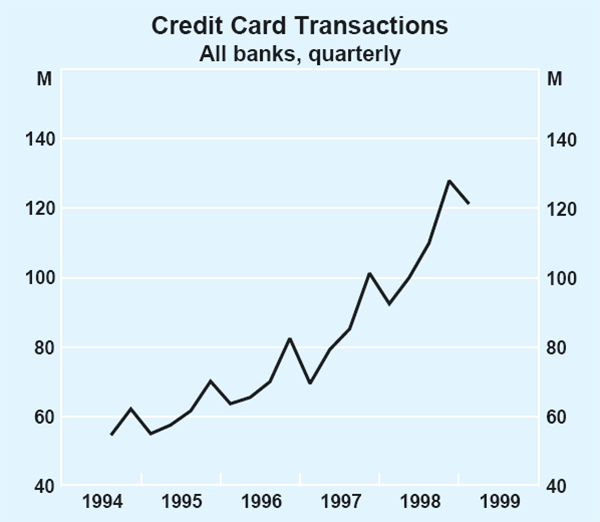
- monthly advances and repayments have also increased strongly in recent years, largely in parallel with each other, indicating that most new advances on credit cards are repaid each month (see Graph 4).[2]
This leaves something of a puzzle: if most new advances on credit cards are repaid, why is the stock of debt on issue rising so strongly? An important factor is that part of the growth in credit card debt from month to month reflects mismatches between the timing of purchases of goods and services and the monthly credit card repayment. As banks report all outstanding balances at end-month (even those on which no interest is yet payable), increasing recourse to making payments with credit cards will tend to be associated with a rising level of debt outstanding.
Interest Rates
The range of products available in the personal lending market is diverse. This is reflected in the spectrum of interest rates available (Table 1).
| Current level | Change since June quarter 1996 |
|
|---|---|---|
| Personal lending | ||
| Secured | ||
| – Fixed-term | 9.30 | −2.15 |
| – Revolving line of credit | 6.60 | −4.90 |
| Unsecured | ||
| – Fixed-term | 11.50 | −2.00 |
| – Credit cards with interest-free period | 15.30 | −1.40 |
| – Credit cards without interest-free period | 13.70 | −2.25 |
| Memo items: | ||
| Housing – standard variable | 6.50 | −4.00 |
| Small business – overdraft | 7.45 | −3.80 |
| Cash rate | 4.75 | −2.75 |
The structure of interest rates on personal loans reflects the degree of risk taken by the lender. The lowest personal lending rates are those on residentially secured lines of credit – currently at 6.60 per cent, which is little different from the interest rate on standard variable-rate housing loans (Graph 6). The traditional unsecured fixed-term loan has an interest rate of 11.50 per cent; if secured such a loan incurs an interest rate of 9.30 per cent.
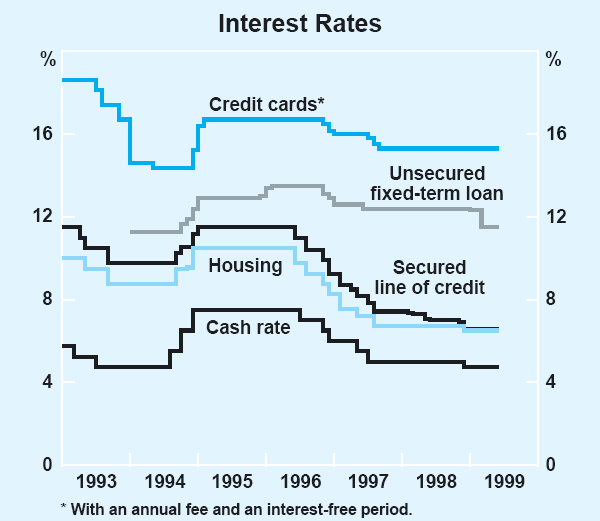
The most expensive form of bank finance remains credit cards, which are essentially an unsecured line of credit. For cards without an interest-free period, interest rates currently average 13.70 per cent, while for cards with an interest-free period, the interest rate currently averages 15.30 per cent. However, as discussed above, not all borrowers who use credit cards pay interest on their balances.
The decline in interest rates on credit cards in recent years has been less than on other household loan products, and less than the cash rate. No doubt this reflects a range of factors, including banks' costs and bad debt experience, but it may also be that this market is less ‘price-sensitive’ than other lending markets: to the extent that many consumers expect to pay their credit card debts each month, the interest rate on the credit card might have little effect on the use of the card. Moreover, as discussed in ‘Recent Developments in Interest Rates on Bank Lending’ in the Reserve Bank of Australia Bulletin of April 1999, the margin on such loans in Australia is at the low end of the range of such margins in other countries.
Some Comparisons
Household debt has increased from about 50 per cent of annual household disposable income at the start of the 1990s, to 90 per cent at present (Graph 7). In real terms, debt per household has doubled in the 1990s to a level of about $40,000, measured in 1998 prices. These rises largely reflect increases in borrowing for housing. Notwithstanding the recent faster growth in personal lending, it remains a relatively small share of total household borrowing, and its contribution to the rise in debt ratios has been small.
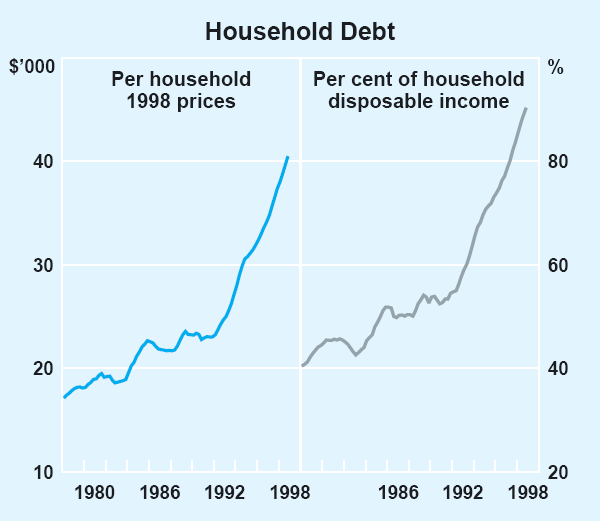
Households' debt servicing burden has declined in the 1990s, after rising strongly in the 1980s. The reduction in interest rates in recent years has seen household interest payments fall to about 6 per cent of disposable income, from a peak of around 9 per cent in 1989/90 (Graph 8), notwithstanding the rise in debt.
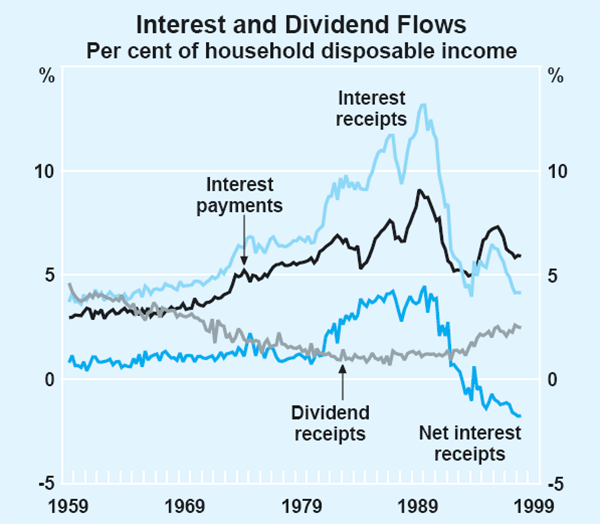
While the ratio of household debt to disposable income in Australia is considerably higher than it was five years ago, it is still in the middle of the range when compared to other countries. The leverage of Australian households is below that in the United States, Japan, the United Kingdom and Canada, while it is comparable to that of households in Germany, Sweden and Spain (Graph 9).
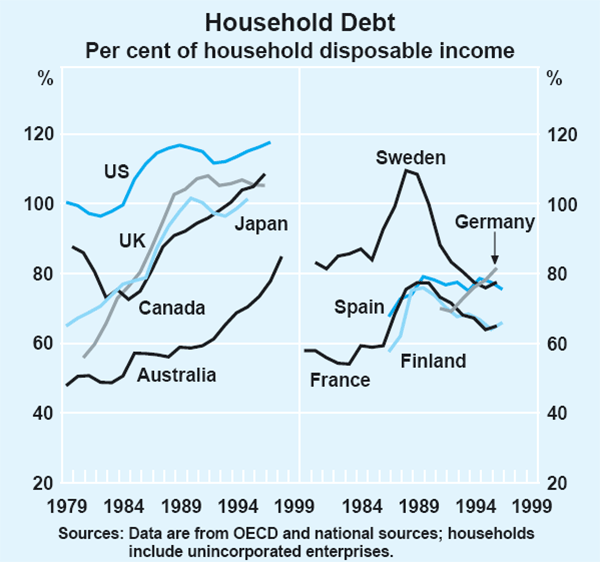
A feature of Graph 9 is that household gearing rose sharply in the 1980s in a number of countries, such as the United Kingdom, Canada and Japan and, to a lesser extent, the United States and Sweden. A major factor in these rises was the process of financial deregulation that occurred in those countries in the 1980s, accompanied by marked reductions in inflation and lower interest rates. While a similar process of deregulation occurred in Australia in the 1980s, inflation remained relatively high, so households were constrained in their borrowings by the associated high level of interest rates. With the reduction in inflation in Australia in the 1990s, some part of the rise in household borrowing might be interpreted as a belated structural change, of the sort evident in several other countries a decade or so earlier.
The rise in household debt in Australia has been accompanied by fast growth in the household sector's assets (Table 2), and an increase in the estimated net asset position of that sector.
| As at June | 1980 | 1985 | 1990 | 1995 | 1998 |
|---|---|---|---|---|---|
| Liabilities(a) | |||||
| Housing credit | 20.1 | 35.5 | 78.4 | 161.3 | 228.6 |
| Personal credit | 8.7 | 20.6 | 44.5 | 45.2 | 60.0 |
| Assets(a) | |||||
| Dwellings | 304.0 | 376.2 | 744.2 | 994.0 | 1,357.3 |
| Financial assets | 94.9 | 195.6 | 409.5 | 587.7 | 836.8 |
| Other assets | 27.4 | 48.8 | 82.3 | 103.7 | 113.6 |
|
(a) Includes securitised loans. Sources: Reserve Bank, ABS and Commonwealth Treasury estimates. |
|||||
Interest-bearing assets have, however, grown more slowly than debt. One consequence of this is that the household sector, in aggregate, has now become a net payer of interest, as shown on Graph 8. This contrasts with experience in earlier decades when the household sector had consistently been a net recipient of interest. This, in large part, reflects changes in households' saving patterns, away from traditional financial assets such as bank deposits and debentures. Since 1980, the ratio of households' interest earning assets to their total holdings of financial assets has fallen from about 50 per cent to under 30 per cent. These assets have been replaced by equity investments and superannuation or pension assets, income from which is not treated as interest receipts. In the 1990s, households' receipts of dividends have increased relative to disposable income, by contrast with earlier experience. The rise in dividend receipts has partly offset the deterioration in households' net interest position.
The build-up in financial liabilities and assets makes households more exposed than previously to adverse movements in asset prices, including from rising interest rates. Accordingly, the impact on economic activity for a given rise in interest rates may be larger than in the past; a drop in share prices might also have larger negative wealth effects than in the past. While this situation might be a cause for concern if the economy were to slow appreciably, or interest rates were to rise sharply, or household gearing were to continue to rise indefinitely, it is important to keep these risks in perspective: household debt ratios in Australia have moved from low levels by international standards early in the 1990s to a position currently still in the middle of the international field, in a climate of stable domestic economic conditions and low inflation.
Footnotes
For an earlier discussion of this topic, see ‘Some Observations on Low Inflation and Household Finances’, Reserve Bank of Australia Bulletin, October 1997. [1]
Recent data from Roy Morgan Research suggest that around three-quarters of credit card holders pay-off at least one credit card per month. Consumers with multiple cards may carry balances from one card to the other. [2]